Jackie Damrau, Editor
Style and Story: Literary Methods for Writing Nonfiction
by Stephen J. Pyne
Using Conversation Analysis for Business and Management Students
by David Greatbatch and Timothy Clark
A2Z+: Alphabets & Signs
by Julian Rothenstein, ed.
Journalism Under Fire: Protecting the Future of Investigative Reporting
by Stephen Gillers
About Design: Insights + Provocations for Graphic Design Enthusiasts
by Gordon Salchow
The Craft of Creativity
by Matthew A. Cronin and Jeffrey Loewenstein
Strategic Communication: An Introduction
by Jesper Falkheimer and Mats Heide
Video Marketing Strategy: Harness the Power of Online Video to Drive Brand Growth
by Jon Mowat
Culture Is Not Always Popular: Fifteen Years of Design Observer
by Michael Bierut and Jessica Helfand
Citizenship and Advocacy in Technical Communication: Scholarly and Pedagogical Perspectives
by Godwin Y. Agboka and Natalia Matveeva, eds.
Generative Design: Visualize, Program, and Create with JavaScript in p5.js
by Benedikt Gross, Hartmut Bohnacker, Julia Laub, and Claudius Lazzeroni
Teaching Professional and Technical Communication: A Practicum in a Book
by Tracy Bridgeford, ed.
The Language of Graphic Design: An Illustrated Handbook for Understanding Fundamental Design Principles
by Richard Poulin
The Teacher’s Role in the Changing Globalizing World: Resources and Challenges Related to the Professional Work of Teaching
by Hannele Niemi, Auli Toom, Arto Kallioniemi, and Jari Laverne, eds.
Outsourcing Technical Writing: A Primer
by Barry Saiff
Readers’ Liberation: The Literary Agenda
by Jonathan Rose
The Messy Middle: Finding Your Way Through the Hardest and Most Crucial Part of Any Bold Venture
by Scott Belsky
Style and Story: Literary Methods for Writing Nonfiction
Stephen J. Pyne. 2018. Tucson, AZ: The University of Arizona Press. [ISBN 978-0-8165-3789-1. 200 pages, including index. USD$19.95 (softcover).]
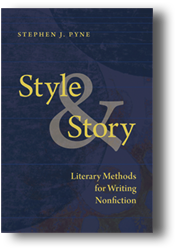 Pyne literally uses a “novel” method to illustrate how nonfiction can be improved by applying the power of openings and closings used in storytelling. He makes the rightful claim that all people love reading stories. Having said this, Pyne proceeds to give us two rules that must govern the use of storytelling in nonfiction. First, we cannot make anything up, not even dialog that might have occurred. The second rule is not to leave anything out that will affect understanding. The voice we use and the approach taken can influence the reader, so they must never be used to deceive.
Pyne literally uses a “novel” method to illustrate how nonfiction can be improved by applying the power of openings and closings used in storytelling. He makes the rightful claim that all people love reading stories. Having said this, Pyne proceeds to give us two rules that must govern the use of storytelling in nonfiction. First, we cannot make anything up, not even dialog that might have occurred. The second rule is not to leave anything out that will affect understanding. The voice we use and the approach taken can influence the reader, so they must never be used to deceive.
Pyne provides numerous examples that demonstrate how common literary techniques can be used to lift the content of a nonfiction piece from instructional to captivating. Irony has been commonly used in the literary world over the past century. Plato’s lectures are lost except for his popular Dialogues. William Shakespeare used Alliteration to turn history into plays. Some of the other literary techniques illustrated in Style and Story: Literary Methods for Writing Nonfiction are: Parody, Satire, Saga, Allegory, and Argument.
For example, Pyne considers Gibbon’s tale about the Roman Empire. The book was written as Cicero would have spoken. But Gibbon wisely uses the tool of Parallelism to integrate much information into a short space. Historians who reference Gibbon’s work most often quote those parallel paragraphs. Pyne includes an example of Parody written by Andy Byron; this fake letter in an academic voice denies Indiana Jones requested tenure at a college’s Department of Anthropology. Wallace Stegner created a Saga from a collection of essays/journals about the desert crossings of fresh Mormon converts who were escaping the poverty of Cornwall and Wales. An example of Allegory is a piece written by John McFee about Plymouth Rock. It has splintered several times, been moved, and reinforced with bars. Yet it remains a symbol for America and the rocky times it has/is enduring.
Technical communicators in the corporate arena are limited to writing procedural manuals, with an occasional task of marketing writing for the web thrown in. Often left to the subject matter experts (SMEs) are the white papers, explanatory materials, and concept writing which could benefit from applying principles demonstrated by Pyne. Although SMEs are less forgiving when technical communicators alter their content, they may be pleased with the addition of a literary-style opening and closing that helps capture the interest of intended readers.
Style and Story reinforces the fact that good design improves reader comprehension, while poor design detracts from the content. Design does not always have to be of a graphic nature. Written stories leap off the page with the opening voice of the writer “leading the way” to important content, followed by a closing designed to satisfy the reader.
Donna Ford
Donna Ford has been an STC member and a technical writer in the hardware, software, and government healthcare industries. She holds an Information Design certificate from Bentley College. Donna is an author who also reviews books online for the US Review of Books.
Using Conversation Analysis for Business and Management Students
David Greatbatch and Timothy Clark. 2018. Thousand Oaks, CA: SAGE Publications. [ISBN 978-1-4739-4826-6. 110 pages, including index. US$29.00 (softcover).]
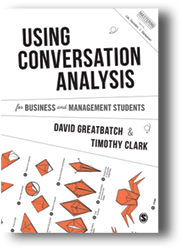 Research design is one of the most difficult tasks that both advanced undergraduates and graduate students must learn. Students in business, technical writing, and other fields that use both qualitative and quantitative research can easily become overwhelmed with the sheer amount of research methodologies available to them. Greatbatch and Clark’s Using Conversation Analysis for Business and Management Students is the latest in the Mastering Business Research Series, edited by Bill Lee, Mark NK Saunders, and VK Narayanan. The aim of each book in this series is to illuminate a research method for students undertaking research in the business fields; however, Greatbatch and Clark’s book would be just as useful for upper level students in technical communication and other related fields.
Research design is one of the most difficult tasks that both advanced undergraduates and graduate students must learn. Students in business, technical writing, and other fields that use both qualitative and quantitative research can easily become overwhelmed with the sheer amount of research methodologies available to them. Greatbatch and Clark’s Using Conversation Analysis for Business and Management Students is the latest in the Mastering Business Research Series, edited by Bill Lee, Mark NK Saunders, and VK Narayanan. The aim of each book in this series is to illuminate a research method for students undertaking research in the business fields; however, Greatbatch and Clark’s book would be just as useful for upper level students in technical communication and other related fields.
Using Conversation Analysis is concise and well organized. The introduction chapter begins with defining conversational analysis (CA), and then takes the reader through the general history and uses of this research methodology. Subsequent chapters cover the philosophical assumptions of this methodology, the various contexts and ways in which to use CA, an overview of studies that have used CA, and a discussion of the strengths and weaknesses of the methodology. Each chapter is followed by a short summary of the main points covered within the chapter.
The greatest strength of Greatbatch and Clark’s text is the clear explanation of what CA does, and does not, do. As a researcher who often employs both conversational analysis and textual analysis, a related method, I appreciated the careful discussion of the distinctions between CA and other research methodologies. Most research methodologies use a deductive method: that is, they begin with a hypothesis and then set out to disprove that hypothesis. Instead, CA typically begins with a scenario, to which the researcher observes and records, and then begins to tease out patterns in the interaction in an inductive approach. Both conversation and textual analysis are frequently criticized for their lack of empiricism as well as the lack of a focused hypothesis. However, CA can be a powerful tool for exploring the interactions between people, or even groups, in a variety of situations which cannot be measured by empirical methods.
The generous use of examples, both hypothetical and of actual published studies, is another asset of this text. Students often struggle to locate appropriate examples of their chosen methodology. Greatbatch and Clark make this task much simpler and easier to understand by interspersing these examples throughout the text, as well as by discussing the context of each example, how the study used CA, and how the results were then analyzed by the researchers.
Using Conversation Analysis is a practical guide that would be a valuable resource for any upper-level student in the business or communication fields. This book is practical and clear enough for even undergraduates to understand. The chapters cover all the possible uses of conversational analysis in just enough detail and with enough examples for students to grasp the concept and complete their own research projects.
Nicole St. Germaine-Dilts
Nicole St. Germaine-Dilts is an Associate Professor Associate Professor of English in the Technical and Business Writing Program at Angelo State University. Her research interests include technical communication for international and intercultural audiences and technical communication in the health fields.
A2Z+: Alphabets & Signs
Julian Rothenstein, ed. 2018. Hudson, NY: Princeton Architectural Press. [ISBN 978-1-61689-707-9. 318 pages. US$40.00 (softcover).]
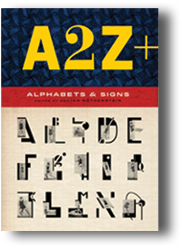 The A2Z+: Alphabets & Signs book is a collection of “alphabets intended to find their public realization on shop fronts and bar signs, elegant eye charges for the optician’s patient, letters and signs for technical manuals, fine typographies for beautiful books, a magisterial Constructivist alphabetic ballet, and so on” (p. 16). True to the statement, the book contains a variety of images, signs, and text that share one common element: beautiful design.
The A2Z+: Alphabets & Signs book is a collection of “alphabets intended to find their public realization on shop fronts and bar signs, elegant eye charges for the optician’s patient, letters and signs for technical manuals, fine typographies for beautiful books, a magisterial Constructivist alphabetic ballet, and so on” (p. 16). True to the statement, the book contains a variety of images, signs, and text that share one common element: beautiful design.
One image that I feel sets the mood for the book is found on page 8 and reads “A Man of Letters, UK, c.1890.” The image is indeed a man made of letters in which his hat is a ‘p’ and his face a ‘u.’ You can stare at the image of the crudely drawn man and continue finding various letters. I find the image to be a wonderful representation of Beatrice Warde’s claim, “Printing should be invisible” (p. 12). The book is filled with media that uses beautiful design to convey meaning.
The introduction is clear to point out that the book “has no program and it has no system of presentation; it confuses categories and obeys no rules. It reflects, rather, the taste and interests of the editor: his affection for the wayward as well as the rigorous in matters of design and typography, his love for all manner of alphabets, lettering, typography, and sign-making” (p. 16). A2Z+ does, however, use full color pages to distinguish one category from the next. These categories range from geographical locations to concepts or themes.
I found the section depicting media from the United Kingdom, starting on page 83, to be my favorite. This section included unique images and concepts, including a “phrenological head mapping the sites of faculties and characteristics, UK, 19th century” (p. 90) and “sign language alphabets, UK, dates unknown” (p. 87). As a psychology undergraduate and someone that spent some time studying sign language, I found these items of interest, especially when considering the design and typography.
I encourage you to pick up A2Z+: Alphabets & Signs and find your favorite designs; there are a multitude to choose from.
Sara Buchanan
Sara Buchanan is an STC member and a technical writer at LCS is Cincinnati, OH. In her free time, she’s an avid reader, enjoys cooking, and doting on her cats, Buffy and Spike.
Journalism Under Fire: Protecting the Future of Investigative Reporting
Stephen Gillers. 2018. New York, NY: Columbia University Press. [ISBN 978-0-231-16887-8. 242 pages, including index. US$28.00 (softcover).]
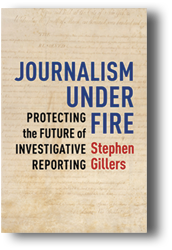 At a time when the press and investigative journalism are under powerful attack—“fake news,” “enemy of the people”—legal scholar Stephen Gillers has stepped forward with a bold program to protect the future of investigative reporting.
At a time when the press and investigative journalism are under powerful attack—“fake news,” “enemy of the people”—legal scholar Stephen Gillers has stepped forward with a bold program to protect the future of investigative reporting.
Gillers argues that by uncovering what powerful actors might wish to conceal—abuses of power, threats to democratic institutions, and other dangers—investigative journalism constitutes a public good that is vital to our democracy and benefits us all. Moreover, the press is unique and irreplaceable, safeguarding us by often doing things that others—courts, legislatures—cannot or will not do, or have just overlooked. But to do its job, the press needs protection.
The Press Clause of the First Amendment—“Congress shall make no law abridging … the freedom of the press,”—provides a foundation for such protection. But, as Gillers shows, the Founding Fathers left it to others—legislatures and the courts—to fill in the details, resulting in a patchwork of laws enforced primarily by the press’s limited ability to finance litigation. Much of Gillers’ book is devoted to analyzing the current state of journalism law regarding a number of thorny issues, laws of libel, shield laws protecting journalistic sources, press access to government records, and much else.
In recent years, he shows, the Supreme Court has tended to ignore the press clause altogether, granting no protections beyond those entailed by its close cousin, the Speech Clause. Gillers argues that this is a grave mistake. Correctly understood, he believes, the Press Clause grants special protections, rights, and privileges, which the press earns by doing its job well, by exercising editorial judgement in what it chooses to investigate, how it investigates, and what it chooses to report.
However interpreted, the press clause can only do so much. Powerful actors both in and out of government, have many ways to impede the press’s ability to dig up facts or punish it for what it reports—Freedom of Information Act (FOIA) non-compliance, Strategic Litigation Against Public Participation (SLAPP) suits, Ag-gag laws, libel suits filed not to be won, but to punish journalists by making them hire attorneys, to name but a few.
Gillers offers a bold program of reforms to provide a protected space in which journalists can do their job. He would strengthen FOIA to make it more responsive to press requests and less costly to enforce. He advocates a federal anti-SLAPP statute, and a guaranteed right of appeal in libel cases. To replace the loss of advertising revenue that used to support investigative journalism, Gillers would establish a publicly endowed fund for investigative journalism like those that currently exist for the arts and humanities.
Gillers is under no illusions that his program will be adopted anytime soon, but his superb examination of where we are and where we should be headed is immensely valuable, nevertheless.
Patrick Lufkin
Patrick Lufkin is an STC Fellow with experience in computer documentation, newsletter production, and public relations. He reads widely in science, history, and current affairs, as well as on writing and editing. He chairs the Gordon Scholarship for technical communication and co-chairs the Northern California technical communication competition.
About Design: Insights + Provocations for Graphic Design Enthusiasts
Gordon Salchow. 2018. New York: Allworth Press. [ISBN 978-1-62153-654-3. 208 pages, including index. US$19.99 (softcover).]
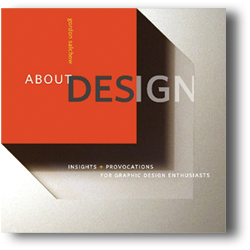 About Design: Insight + Provocations for Graphic Design Enthusiasts on the outset appears to be an introductory text for young designers. However, as you dig into the content, it becomes clear that it is intended to serve another purpose. This book is broken into five sections: Prelude, Form, Aesthetics, Education, and Miscellany. The first three sections provide the basic introductory information one would expect to find in a book about graphic design for students, with treatise on design principles and elements, as well as harmony and balance, and yet there is a problem with this notion.
About Design: Insight + Provocations for Graphic Design Enthusiasts on the outset appears to be an introductory text for young designers. However, as you dig into the content, it becomes clear that it is intended to serve another purpose. This book is broken into five sections: Prelude, Form, Aesthetics, Education, and Miscellany. The first three sections provide the basic introductory information one would expect to find in a book about graphic design for students, with treatise on design principles and elements, as well as harmony and balance, and yet there is a problem with this notion.
About Design assumes quite a bit of knowledge from new students, and it does not provide a collection of images to help the reader to visualize and understand the theories it presents. While there are a few minimalistic illustrations provided by the author’s daughter (also a designer), the overall lack of images is problematic for a book of its nature. As such, this book seems to be better as a companion to other such resources as it offers some exceptional insights and explanations not found elsewhere. It would not be a good book to stand alone as an introduction to graphic design.
Once you reach the Education section, About Design takes on a different track altogether. This section consists mostly of a keynote address given by Salchow as a symposium at the University of the Arts, which is clearly directed to educators and talks of the history of graphic design education in America as well as best curricular practices. It is this section that clearly identifies the book’s target audience as design educators, thus it becomes clear that the entire text is intended, not as an introduction to design for students, but instead as a resource for design educators.
Design educators will find About Design to be an excellent resource to help explain the basics of design to students, and it also provides a lot of insight into the history of design education in America as well as curricular trends and ideas. It indeed provides provocations as the title suggests, it contains some bold statements that some designers might take issue with, such as “There is no such thing as an S-curve” (p. 58) and “There is no such thing as negative space” (p. 73). Yet these statements include explanations that support Salchow’s arguments that might make even the most determined designer reconsider their position. Besides appealing to design educators, this book will also be an excellent resource for students learning their trade, as it is a suitable resource to supplement lectures given in class or read along with other introductory texts.
Amanda Horton
Amanda Horton holds an MFA in Design and currently teaches graduate and undergraduate courses at the University of Central Oklahoma (UCO) in the areas of design technology, design studio, and history of graphic design. She is also the director of the Design History Minor at UCO.
The Craft of Creativity
Matthew A. Cronin and Jeffrey Loewenstein. 2018. Stanford, CA: Stanford University Press. [ISBN 978-1-5036-0507-7. 270 pages, including index. US$29.95 (softcover).]
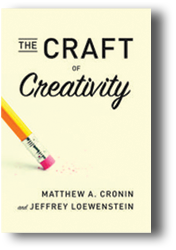 What do trains and kingfishers have in common? If you thought twice about the answer, then you’ve just begun the process of changing your perspective. This is the cornerstone of creativity according to Cronin and Loewenstein.
What do trains and kingfishers have in common? If you thought twice about the answer, then you’ve just begun the process of changing your perspective. This is the cornerstone of creativity according to Cronin and Loewenstein.
In The Craft of Creativity, the authors challenge readers to change their perspectives on creativity itself. Many believe they’re incapable of being creative or that creativity is only bestowed on special people. Cronin and Loewenstein use stories, riddles, and puzzles as a foundation to make it clear that anyone can be creative. Creativity is a skill that requires time and effort to develop; hence, it is a craft.
We often focus on creative products instead of the process it takes to make them. But being creative involves “developing different ways of thinking so that what was inconceivable becomes thinkable” (p. 2). In Japan, the Shinkansen Train is famous for its long nose. This nose is the product of a creative process in which engineers reimagined how to make the train quieter while traveling through tunnels. The realization that a kingfisher’s streamlined beak enables it to handle rapid changes in pressure, and that this concept could be applied to the train, is an example of “insight.” And insights often lead to “inventions” and “enlightenments,” which help us advance our stories, turn “fiction into reality” (p. 119), and build new knowledge.
“Cues” signal when a change of perspective is needed. For example, “impasse” provides “the feeling that we are stuck and that there is nothing we can do to productively advance our story” (p. 133). The Stoplight Model of Creativity tells us to “stop advancing our story and instead turn our energies to our perspective” (p. 54). When the light is green, we use craft to advance our story. But when it’s red, that’s our cue to switch to creativity. “Cognitive tools” can help us depart from our current perspectives. We can use “activation” to bring concepts into our working memory, form “analogies,” join concepts together that are initially inconceivable as a “combination,” and swap one concept for another to make sense of something (recategorization).
Creativity also requires commitment. Uncertainty causes us to second-guess ourselves and debate if creativity is even worthwhile. We cling tightly to our assumptions and stepping away from them is intimidating. Therefore to fully develop our craft of creativity, we must learn the importance of “managing our emotions and maintaining our motivation to continue our stories in the face of uncertainty” (p. 188).
The “craft of creativity” concept is explained many times throughout The Craft of Creativity. However, the final chapter provides its simplest form: “Craft is how we make use of creativity, and creativity is how we extend craft” (p. 219). Cronin and Loewenstein certainly make it hard to deny that creativity is central to the craft of technical communication. And in the face of uncertainty driven by the rise of artificial intelligence and machine learning, it seems creativity may be the most important skill that technical communicators can develop.
Amy Dunbar
Amy Dunbar is an STC member and a technical writer for Pearson VUE in Bloomington, MN. She has a degree in biology and a graduate certificate in technical communication from the University of Minnesota. Amy’s professional interests include content marketing, video production, and information design.
Strategic Communication: An Introduction
Jesper Falkheimer and Mats Heide. 2018. New York, NY: Routledge. [ISBN 978-1-1386-5703-8]. 159 pages, including index. US$39.95 (softcover).]
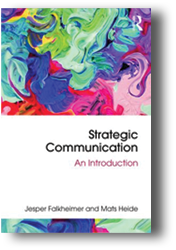 Jesper Falkheimer and Mats Heide, professors in strategic communication at Lund University, Sweden, have written what they intend to be an undergraduate textbook. Indeed, they claim Strategic Communication: An Introduction to be the first such textbook to cover strategic communication—based not only on empirical research but also on their own experience from practice. The authors’ “main aim . . . is to give . . . students a general overview of theories, concepts and methods in strategic communication” (p. vii).
Jesper Falkheimer and Mats Heide, professors in strategic communication at Lund University, Sweden, have written what they intend to be an undergraduate textbook. Indeed, they claim Strategic Communication: An Introduction to be the first such textbook to cover strategic communication—based not only on empirical research but also on their own experience from practice. The authors’ “main aim . . . is to give . . . students a general overview of theories, concepts and methods in strategic communication” (p. vii).
Strategic Communication is divided into three sections. In the first section (Fundamentals), the authors examine the basic parts that comprise strategic communication (strategy and communication) and then reassemble them to define strategic communication as the “purposeful use of communication by an organization to fulfill its mission” (p. vii). Strategic communication includes internal, external, formal and informal communication, and occurs at all levels of an organization. In discussing strategic communication, Falkheimer and Heide differentiate it from corporate communication and communication management.
In Part II (Communication processes and organizations), Falkheimer and Heide delve into the important functions of strategic communication. With society becoming more “liquid,” having more potential communicators, “strategic communication capabilities have become more relevant . . ., used to communicate, negotiate, and shape perceptions of legitimacy between organizations and society” (p. 91). One such capability is communicating organizational changes, sometimes in crisis mode, to board members, consumers, and other stakeholders. Not only do these communications happen outside the organization, but, most importantly, the culture of a successful organization is based on effective internal strategic communication.
The third part of Strategic Communication (Future developments) highlights future trends Falkheimer and Heide would like to see. Because it is hard to quantify the value of strategic communication to an organization, they stress the continuing need for research, both traditional quantitative research as well as observations of strategic communication in practice, to provide this kind of analysis. In addition, the authors challenge communicators to continually be aware of the ethical issues involved in applying the tactics of strategic communication. Falkheimer and Heide also emphasize the need for flexibility in communication planning that allows for more innovation. They conclude their look into the future by introducing the communicative organization model, launched in Europe in 2010, as a goal for organizations.
As European academics, Falkheimer and Heide have a decidedly European point of view on the history and practice of strategic communication, citing research by many of their peers and examples of organizations from within a European context, such as the Swedish national police authority. Yet many of their observations align with what I have experienced here in the US. For this reason, I think this book would be an excellent resource for anyone who wants a universal look at the practice of strategic communication. The authors themselves recommend Strategic Communication for “practitioners in communications, management, marketing . . . who want to develop their thinking and doing” (p. xiv).
Linda Davis
Linda M. Davis is an independent communications practitioner in the Los Angeles area. She holds an MA in Communication Management and has specialized in strategic communication planning, publication management, writing, and editing for more than 25 years.
Video Marketing Strategy: Harness the Power of Online Video to Drive Brand Growth
Jon Mowat. 2018. London, England: Kogan Page Limited. [ISBN 978-0-7494-8159-9. 278 pages, including index. US$29.95 (softcover).]
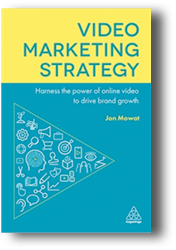 Over the past decade, the rise of social media and the Internet has disrupted nearly every business area. In the past, businesses budgeted money for television advertising. However, with the digital age, social media advertising is taking over causing marketers to change their strategy.
Over the past decade, the rise of social media and the Internet has disrupted nearly every business area. In the past, businesses budgeted money for television advertising. However, with the digital age, social media advertising is taking over causing marketers to change their strategy.
In Video Marketing Strategy: Harness the Power of Online Video to Drive Grand Growth, Mowat says, “We are entering a Video First world, backed by the biggest brands and social media platforms . . . . [V]ideo has proven itself to be an incredibly powerful way of affecting behaviour, and technology has advanced to the point where video can take over” (p. xviii).
The author sets the stage in Section 1, “Video marketing strategy: an introduction,” by describing video marketing and why it works. He immediately captures the reader by describing the Razor Wars between Gillette and new subscription-based startups. Until then, Gillette had been investing millions of dollars into fending off its rival Unilever. But, a start-up, the Dollar Shave Club, suddenly appeared on the scene with YouTube videos to market their products. Because of the success of the Club’s products, Unilever purchased the Dollar Shave Club for $1 billion. Mowat noted there was no advantage or innovation in the blades. But, “by using innovative marketing techniques they changed the playing field and built a massive brand in just four years” (p. 5).
Mowat includes a link to their March 2012 video in the book’s website, www.video-marketingstrategy.com, which also contains all the book’s example videos.
The meat of the book, Section 2, “Creating great videos”, addresses how to plan videos, along with the magic formula: Story/Planning X Activation = Great Content. Stories convey emotion, such as happy, sad, afraid, and angry. The next tier of emotions include security, enjoyment, excitement, adventure, autonomy, and discipline. It’s important to convey emotion in videos, as people generally see about 5,000 ads a day. Mowat stresses your video must pass the “So What?” test, as the modern consumer has decision fatigue. He includes important details in this section, such as the length of titles for YouTube videos where Mowat recommends keeping it under 70 characters, and suggests doing repeated testing of the thumbnails.
In Section 3, “DIY video projects,” he walks you through creating and editing your own video projects. As a former camera and edit trainer for the BBC, Mowat has taught many people how to make videos using their smartphone. He offers simple, but great, suggestions, such as taking a minute to record background noise without the interviewee talking. You can later use the background if you need to edit in your own sound effects.
Lastly, in Section 4, “Creating effective video campaigns,” Mowat breaks down video campaigns with their many entry points and simplifies it to a six-step process.
You’ll find the numerous references and Video Marketing Strategy’s website of video links tremendously helpful when planning your next marketing video.
Rhonda Lunemann
Rhonda Lunemann is a technical writer with Siemens PLM Software, is a senior member and serves on the Program Committee of STC’s Twin Cities Chapter.
Culture Is Not Always Popular: Fifteen Years of Design Observer
Michael Bierut and Jessica Helfand. 2018. Cambridge, MA: MIT Press. [ISBN 978-0-262-03910-9. 232 pages, including index. US$39.95.]
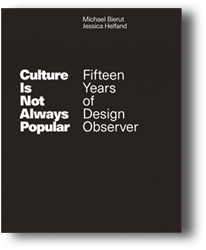 The Design Observer is a website founded in 2003 by leading designer/writers Rick Poynor, William Drenttel, Jessica Helfand, and Michael Beirut that publishes articles broadly on topics relating to design and culture. Culture is Not Always Popular: Fifteen Years of the Design Observer is a celebration of the site’s 15th anniversary and the result of the Design Observer cofounders’, Bierut and Helfand, efforts.
The Design Observer is a website founded in 2003 by leading designer/writers Rick Poynor, William Drenttel, Jessica Helfand, and Michael Beirut that publishes articles broadly on topics relating to design and culture. Culture is Not Always Popular: Fifteen Years of the Design Observer is a celebration of the site’s 15th anniversary and the result of the Design Observer cofounders’, Bierut and Helfand, efforts.
This book contains 67 articles from an assortment of contributors, many of whom are well respected leaders of the design community. The articles are presented in five categories: Critical Commentary, Cultural Investigation, Will and Whimsy, Reason and Responsibility, and New Vernaculars. The authors selected these articles as a representative of the diversity and dynamic topics that are often discussed on the site but not necessarily as a “best of” collection. Each article is presented with its original publication date on the Design Observer website which is helpful in establishing a frame of reference, though many of the topics are still relevant today. Also included is a selection of two or three of the comments, which in many cases is a brief sampling of what was originally posted as a response, and the editors did not shy away from posting comments that were counter to the author’s ideas or opinions, indicating in many instances that a heated debate had taken place. Do not skip the comments—they contain good information and are also often very entertaining to read.
One may wonder what the benefits of reading this collection of essays would be, since all the articles can be accessed for free on the website. The collection is carefully curated representing the diversity of topics covered over the years at Design Observer, which is nice if you don’t have time to read all 6,700 plus articles on the website. Additionally, since there are only a few comments published in the book alongside each article you can avoid falling down the potential “rabbit hole” of comments and debate that follows many of the site’s articles.
Culture is Not Always Popular does have its downsides. While the original articles were often accompanied by images that supported the content, these images are sparsely included in the book, sometimes to the detriment of the article’s content. For example, “Comparakeet” by Kathleen Meaney originally displayed a collection of fourteen images for comparison on the website, however the book’s published version only includes four images. Many of the missing images are referenced in the article, and their exclusion limits the readers understanding of the essay’s content. Despite this, there are more reasons than not to enjoy the collection of essays within Culture is Not Always Popular; the articles are often witty and always intelligent, and the book is indeed a sampling of the culture of design over the last fifteen years.
Amanda Horton
Amanda Horton holds an MFA in Design and currently teaches graduate and undergraduate courses at the University of Central Oklahoma in the areas of design technology, design studio, and history of graphic design. Ms. Horton is also the director of the Design History Minor at UCO.
Citizenship and Advocacy in Technical Communication: Scholarly and Pedagogical Perspectives
Godwin Y. Agboka and Natalia Matveeva, eds. 2018. New York, NY: Routledge. [ISBN 978-1-138-56080-2. 332 pages, including index. US$45.95 (softcover).]
 Citizenship and Advocacy in Technical Communication: Scholarly and Pedagogical Perspectives has the privilege of being the first edited collection on this topic. Though, as the authors admit, advocacy work has been a longstanding part of the technical communication field, the collection seeks to cover “the complexities of undertaking advocacy work in technical and professional communication, including local grant writing activities, cosmopolitanism and global transnational rhetoric, digital citizenship and social media use, strategic and tactical communication, and diversity and social justice” (p. xxix). The authors define advocacy as “the process of using a combination of academic and practical skills and knowledge systems to enact social justice with the goal to improving the quality of life for communities” (p. xxix).
Citizenship and Advocacy in Technical Communication: Scholarly and Pedagogical Perspectives has the privilege of being the first edited collection on this topic. Though, as the authors admit, advocacy work has been a longstanding part of the technical communication field, the collection seeks to cover “the complexities of undertaking advocacy work in technical and professional communication, including local grant writing activities, cosmopolitanism and global transnational rhetoric, digital citizenship and social media use, strategic and tactical communication, and diversity and social justice” (p. xxix). The authors define advocacy as “the process of using a combination of academic and practical skills and knowledge systems to enact social justice with the goal to improving the quality of life for communities” (p. xxix).
The book is broken into 14 chapters that span three main sections: “Defining Core Competencies for Local and Global Advocacy and Citizenship,” “Choosing the Right Approaches to Advocacy and Community Engagement: Working with a Real Client,” and “Introducing Advocacy Techniques in the Classroom.” It is geared towards academics interested in these topics. Many of the approaches discussed, like “asset-based inquiry” (p. 23); “intercultural analysis” (p. 111); and “community-engaged learning” (p. 223), will be familiar to academic readers but possibly unfamiliar to practitioners. The book’s chapters are also written from the academics’ perspectives working within institutions of higher education, though many of the authors describe work with communities as diverse as technical communication students in online classes, a chemistry department in a university, and science journalists. So, overall, Citizenship and Advocacy in Technical Communication provides a wide-ranging view of the topic of advocacy for academics working in a variety of contexts (research-based, client-based, classroom-based, etc.).
At the same time, practitioners of advocacy work beyond academia will probably find the collection to be difficult to parse. Technical communicators wishing to work with a local non-profit or activist group, for instance, may struggle to understand complex terms used throughout the collection. Such readers will gain a valuable insight into the academic field of technical communication and the work accomplished within this field around the goal of improving the quality of life for communities. Thus, practitioners wishing to collaborate with academics on projects of mutual interest may find the collection useful for understanding how such projects are launched and managed.
Academic readers, on the other hand, will find a plethora of interesting approaches to advocacy work that they can apply immediately. Such readers looking to improve their existing efforts to improve the lives of a variety of stakeholders, or to begin advocating on behalf of new community members, will find many best practices and novel approaches within the collection.
Overall, Citizenship and Advocacy in Technical Communication is an exciting and necessary contribution to academic scholarship on this topic that will likely have a large impact on future conversations.
Guiseppe Getto
Guiseppe Getto is a faculty member at East Carolina University. He is also President and Founder of Content Garden, Inc., a digital marketing and UX consulting firm.
Generative Design: Visualize, Program, and Create with JavaScript in p5.js
Benedikt Gross, Hartmut Bohnacker, Julia Laub, and Claudius Lazzeroni. 2018. Hudson, NY: Princeton Architectural Press. [ISBN 978-1-61689-758-1. 256 pages. US $45.00 (softcover).]
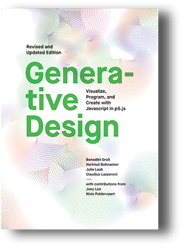 Generative Design: Visualize, Program, and Create with JavaScript in p5.js is an attractive, engaging book, from the moment one gives it a quick glance and is amazed by the picture’s art quality, to the moment one digs into the details of the code and one’s mind is exposed to the possibilities of generative design.
Generative Design: Visualize, Program, and Create with JavaScript in p5.js is an attractive, engaging book, from the moment one gives it a quick glance and is amazed by the picture’s art quality, to the moment one digs into the details of the code and one’s mind is exposed to the possibilities of generative design.
The book’s main content is titled “Basic Principles,” which makes it obvious to the reader that this is not a book to gain expertise in generative design, but more of an introduction to the subject and the use of p5.js.
The “Basic Principles” section is divided into five sections: Introduction to p5.js, Color, Shape, Type, and Image. The “Introduction to p5.js” section is heavily focused on JavaScript language syntax and concepts. Any readers already familiar with any programming language will go rapidly through this section without any issues.
Even if you have no prior programing experience, I would recommend you try reading the Introduction, and if you feel overwhelmed with programming concepts, pause for a moment, and go online and look for a quick introduction to a beginners JavaScript course. Once you understand the JavaScript fundamentals, you can more easily take advantage of what Generative Design has to offer.
The rest of the subchapters are example-based exercises that guide you by the hand regarding the important code pieces that are critical for creating the different designs and algorithms. The reader does not need to manually copy these code examples from the book, as the book includes a link to its website where you can download all the examples (source code) to run them on your computer. Besides the source code download links, the website allows you to run the examples directly in it without downloading all the source code. However, I would recommend that readers download the source code as that would allow them to edit the source code and experiment with the variables in each example. You may be surprised at how easy it is to create completely new designs by experimenting with the code variables.
I greatly enjoyed reading Generative Design. This book is one that will remain on my bookshelf and be referred to over and over as code samples have very interesting algorithms that I want to review a second time to get a deeper understanding and train my brain to think with the generative design mindset.
Uriel Cota
Uriel Cota is a civil engineer, software developer, and former teacher with over 10 years of experience in Web development.
Teaching Professional and Technical Communication: A Practicum in a Book
Tracy Bridgeford, ed. 2018. Logan, UT: Utah State University Press. [ISBN 978-1-60732-679-3. 248 pages, including index. US$30.95 (softcover).]
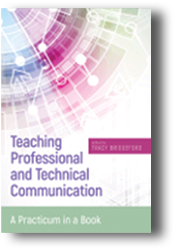 When I first taught technical writing, I had no pedagogical tools except some notes from another instructor, a few learning goals, and a course description. Over the years, I honed my course content through trial and error, applying ideas from conferences and talks with other faculty, textbooks, and journal articles. I wish I had had Teaching Professional and Technical Communication: A Practicum in a Book, a book that presents “pragmatic knowledge about instruction” (p 3).
When I first taught technical writing, I had no pedagogical tools except some notes from another instructor, a few learning goals, and a course description. Over the years, I honed my course content through trial and error, applying ideas from conferences and talks with other faculty, textbooks, and journal articles. I wish I had had Teaching Professional and Technical Communication: A Practicum in a Book, a book that presents “pragmatic knowledge about instruction” (p 3).
Targeted to those new to teaching professional and technical communications (PTC), this book offers thirteen chapters on core competencies, from basics like teaching rhetorical analysis or writing procedures to more advanced topics like teaching collaboration or intercultural communication. Terms are well defined, and the content written in a clear style. While reading this, new teaching assistants will feel welcomed to the profession; seasoned professionals will have a reference text to support their current practices.
Each chapter is structured similarly with a brief literature review that sets the topic’s context and theory. For those teaching in PhD programs, whether specific to technical and professional writing or composition and rhetoric more generally, the chapters provide excellent references for assigning further reading for graduate students. Each chapter ends with discussion questions perfect for the graduate seminar. For those in the classroom, the chapters deliver practical approaches. The authors start with a classroom scenario for teaching a competency, such as presentations, and narrate through teaching that competency, including practical applications for in-class activities and assignment sequences.
It’s about time our field gets a text like this, one that helps educate new instructors on some of the best practices for introductory PTC and service courses. As a well-written and practical book, it is sure to be widely disseminated—to STEM faculty, to composition faculty, and to graduate students assigned to a technical writing course for the first time.
Expect future texts to expand upon this material. For example, Teaching Professional and Technical Communication has an excellent chapter that argues for teaching style, especially for non-majors, but the book doesn’t address how to teach the use of and creation of style guides, a topic other academics will likely tackle. Future texts will expand the scope, moving from a practicum for introductory material to practicums on a wider and deeper range of topics.
The text isn’t perfect. For example, the index is clearly an amalgamation of entries created by the various chapter authors rather than a cohesive product of a professional indexer. One entry is “body language during a presentation,” but under “presentations” there is no entry for “body language and” (p. 241). Also, the entry for “audience” (p. 241) has fifteen page numbers with no subentries and an additional three pages for the lone subentry “and presentations.” Unfortunately, most academic texts suffer from similar indexing issues given the costs of hiring an indexer.
Regardless, Bridgeford must be commended for curating what is bound to become a foundational text.
Kelly A. Harrison
Kelly A. Harrison, MFA, teaches technical writing at Stanford University. In collaboration with a colleague, she recently received an NEH grant for curriculum development at San José State University, where she has taught a range of writing courses. She has written print and online content for various high-tech companies.
The Language of Graphic Design: An Illustrated Handbook for Understanding Fundamental Design Principles
Richard Poulin. 2018. Revised and Updated edition. Beverly, MA: Rockport Publishers. [ISBN 978-1-63159-617-9. 296 pages, including index. US$29.99 (softcover).]
 In The Language of Graphic Design: An Illustrated Handbook for Understanding Fundamental Design Principles, Poulin provides aspiring graphic designers with an accessible entry-point into the principles of the field. While this book might give technical communicators who simply want to broaden their understanding of visual design principles more information than they need, the book’s clear, concise descriptions of the principles mixed with compelling examples of the principles in action will keep even reluctant technical communicators interested.
In The Language of Graphic Design: An Illustrated Handbook for Understanding Fundamental Design Principles, Poulin provides aspiring graphic designers with an accessible entry-point into the principles of the field. While this book might give technical communicators who simply want to broaden their understanding of visual design principles more information than they need, the book’s clear, concise descriptions of the principles mixed with compelling examples of the principles in action will keep even reluctant technical communicators interested.
Poulin describes graphic design as a “unique visual language with its own alphabet, lexicon (vocabulary), and syntax (sentence structure)” (p. 6). Each chapter in the book represents one of the 26 graphic design elements, such as line, point, symmetry, image, pattern, and typography. For each element, he provides an extensive definition, a description of the uses of each element, a history of the element in use, and a biography of an important graphic design practitioner who used the element heavily in his or her work. The biography sections also teach the reader the history of the field and show the field’s evolution through time. Each chapter differs in length and scope depending on the complexity of the element Poulin is discussing.
The book’s most compelling aspect is the myriad visual examples of each element in practice in actual flyers, posters, artworks, student projects, and book covers throughout each chapter. The reader will likely recognize many of these examples, such as the new book covers for Albert Camus’ The Stranger, Ernest Hemingway’s The Sun Also Rises, and Charles Shaw wine labels. Because the concepts in each chapter are mostly discrete, readers can choose either to read this book linearly or to skip around to the sections they would like to know more about, which makes The Language of Graphic Design a handy reference book for technical communicators who are concerned with the visual representation of written materials and document design.
While the book is visually striking, the setup of all the text and images is sometimes jarring. The introductory definition for each element is often broken up by the visual examples and biography sections, which forces the reader either to skip past the interruptions to read the text in a coherent manner or jump from image to image and section to section, which can make reading comprehension difficult. However, this is a small problem in a highly informative, engaging book.
Dylan Schrader
Dylan Schrader is a graduate student in the MA in Professional Communication program at the University of Alabama in Huntsville, where he also works as a grant researcher in the Office for Proposal Development.
The Teacher’s Role in the Changing Globalizing World: Resources and Challenges Related to the Professional Work of Teaching
Hannele Niemi, Auli Toom, Arto Kallioniemi, and Jari Laverne, eds. 2018. Brill. 150 pages. ISBN: 978-90-04-37257-3. US$104.00 (softcover).
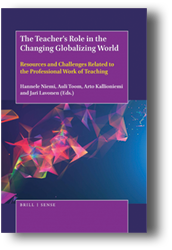 The word that comes to mind when I think of the contents of The Teacher’s Role in the Changing Globalizing World: Resources and Challenges Related to the Professional Work of Teaching is “smorgasbord,” as in a smorgasbord of interesting ideas. The chosen works ably address with their smorgasbord of ideas the notion that the role of teachers today is changing throughout the world. Today, a teacher can do more than teach in a classroom. A teacher can work in new learning environments, especially with an online component. This book addresses this issue as it pertains to the teaching professional and how to protect and address the teacher’s role. Whether you are simply looking to learn more about this topic or want a thoughtful read for your students, The Teacher’s Role in the Changing Globalizing World could be a good choice for you.
The word that comes to mind when I think of the contents of The Teacher’s Role in the Changing Globalizing World: Resources and Challenges Related to the Professional Work of Teaching is “smorgasbord,” as in a smorgasbord of interesting ideas. The chosen works ably address with their smorgasbord of ideas the notion that the role of teachers today is changing throughout the world. Today, a teacher can do more than teach in a classroom. A teacher can work in new learning environments, especially with an online component. This book addresses this issue as it pertains to the teaching professional and how to protect and address the teacher’s role. Whether you are simply looking to learn more about this topic or want a thoughtful read for your students, The Teacher’s Role in the Changing Globalizing World could be a good choice for you.
I was impressed that the articles reflect issues in several locations including China, Estonia, Finland, Malta, Singapore, and the USA. The selection that addresses issues in China, for example, notes that with today’s new technologies a teacher’s traditional role is “facing more and more challenges . . . . Modern teachers are expected to be not only the organizers and designers of the educational process, but also mentors and partners of students in the learning process” (p. 109). The author of this piece on these issues in China also notes that current teacher education in China promotes professional development considering today’s challenges.
In “Teaching in the USA,” we see Dr. Gerald K. LeTendre write about how “the U.S. teaching force presents some unique paradoxes” (p. 91). One of LeTendre’s concerns is how American teachers lack professional autonomy: “Although the U.S. has a highly decentralized educational system, teachers report less involvement in school decisions than in nations with centralized systems like Japan.” He further notes that “paradoxes can be linked to specific organizational and cultural factors such as a strong culture of local school control, a politically divisive national culture, and the growing influence of international comparisons and bench-marking” (p. 91). LeTendre is Professor of Education (Education Policy Studies) at Penn State and a co-editor of The American Journal of Education. His current research focuses on how technology is changing teacher work roles and teacher professional development around the world.
Jeanette Evans
Jeanette Evans holds an MS in technical communication management from Mercer University. She has worked with groups such as Philips Medical and Cuyahoga Community College doing technical writing and supporting courseware development. Jeanette also co-authored an Intercom column on emerging technologies in education and is currently NEO STC newsletter co-editor.
Outsourcing Technical Writing: A Primer
Barry Saiff. 2018. Laguna Hills, CA: XML Press. [ISBN 978-1-937434-64-9. 100 pages. US$19.95 (softcover).]
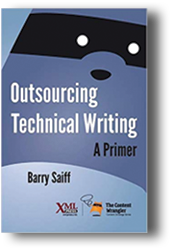 Overall, this is a worthwhile, if light, quick read that covers many basics around managing process change for writing groups, while at the same time tackling some of the common myths around outsourcing. There’s nothing particularly revolutionary within its 100 pages, but it hits the spot as the “primer” promised on the cover.
Overall, this is a worthwhile, if light, quick read that covers many basics around managing process change for writing groups, while at the same time tackling some of the common myths around outsourcing. There’s nothing particularly revolutionary within its 100 pages, but it hits the spot as the “primer” promised on the cover.
In the Preface, Saiff includes a lengthy personal note that describes his background and the story behind the founding and growth of his own Philippines-based outsourcing company. His philosophies used in running his company and management approach form a common thread throughout the rest of the book and are often referenced, which can be a little distracting.
The first couple of chapters cover the basics of outsourcing, with Chapter 2 tackling many of the myths around outsourcing and arguing that many of the aspects of outsourcing that are often viewed as negatives, can in fact have positive results not just for the organization, but for the existing technical documentation teams too.
The second section, covering Chapters 3 and 4, focus on management techniques and are a useful guide for those new to organizational leadership.
Most of Outsourcing Technical Writing: A Primer is devoted to a section entitled “Your Roadmap to Outsourcing Success” but many of the subjects covered could be applied to planning and implementing most types of transformational change. Topics such as process maturity, developing project vision statements and goals, creating plans, budgeting, milestones, metrics, and finding internal sponsorship are of general application.
For those who are considering outsourcing as an operational option, this book concludes with three short, but instructive, case studies, and a sample contract covering the outsourcing of technical writing as a starting point.
Outsourcing Technical Writing is well laid out and clearly organized, making it easy to dip back into. As such, it can be a useful resource and reference in any technical publication manager’s library, whether they are looking into outsourcing or not.
Alan J. Porter
Alan J. Porter is an STC senior member, a member of the STC-Houston chapter, and has worked in the technical communications field for over thirty years. He is also the author of two XML Press books, Wiki and The Content Pool.
Readers’ Liberation: The Literary Agenda
Jonathan Rose. 2018. Oxford, United Kingdom: Oxford University Press. [ISBN 978-0-19-872355-4. 228 pages, including index. US$20.00 (softcover).]
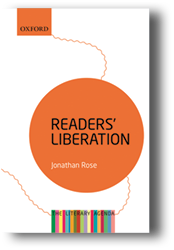 “Fake news” is not a twenty-first century or Trump-era phenomenon. Censorship and mass manipulation have been part of the reading experience that predates the printing press. Freedom and liberation of individuals and societies that read are also part of this experience, and the history of “ordinary readers” has not been something much written about. Readers’ Liberation: The Literary Agenda is part of this relatively new research, where Rose uses “correspondence, diaries, memoirs, and marginalia” (p. vi) as well as library rosters, surveys, bookseller records, and other archives “to create a broad narrative history of reading” with a “central theme: that reading can be and has been the most fundamental expression of human freedom, even in repressive societies” (p. vi). Rose’s book is a captivating reading experience that explores what people read and the connection between reading and larger societal issues.
“Fake news” is not a twenty-first century or Trump-era phenomenon. Censorship and mass manipulation have been part of the reading experience that predates the printing press. Freedom and liberation of individuals and societies that read are also part of this experience, and the history of “ordinary readers” has not been something much written about. Readers’ Liberation: The Literary Agenda is part of this relatively new research, where Rose uses “correspondence, diaries, memoirs, and marginalia” (p. vi) as well as library rosters, surveys, bookseller records, and other archives “to create a broad narrative history of reading” with a “central theme: that reading can be and has been the most fundamental expression of human freedom, even in repressive societies” (p. vi). Rose’s book is a captivating reading experience that explores what people read and the connection between reading and larger societal issues.
Rose begins this discussion with a chapter on what it means to be an independent reader and identifies historical movements and the accompanying texts that broke through barriers intended to subdue writers and readers from questioning established institutions like religious and political regimes. Although the scope of this book is on historical reading habits in the United States, Rose provides brief surveys of the most-read books in other countries and correlates those lists with historical political and social movements. Other chapters explore “middlebrow” reading, and social inequality and access to reading materials.
“Dreamers of the Ghetto” demonstrates most eloquently Rose’s claim that “every revolution begins with liberated reading” (p. 2), where he “sketches in a few outlines” a “much bigger story” (p. 87) about the reading experiences of African-American slaves. His history continues into the Jim Crowe era and beyond where readers squarely encounter the effects of segregation and other deliberate actions to keep African-Americans illiterate and controlled. Likewise, “Shakespeare in Prison” details reading lists and the reading experiences of prisoners, a population that is rarely included in any historical portrait.
The last three chapters cover histories of truth and censorship in journalism, the stranglehold of corporate and governmental public relations on mass media, and present-day threats to reading. “Death to Gradgrind,” reveals economic ties between corporate giants and the promotion of the Common Core, “a set of educational standards that promises ‘career and college readiness’” (p. 183). Rose states that the Common Core “cuts out both teachers and parents in shaping educational policy” (p. 184) and has a detrimental effect on reading where classroom texts are composed almost entirely of “snippets,” grossly cut texts that discourage critical thinking. At the university-level, Rose confronts the trend to provide “trigger warnings” before students read assigned texts and the philosophy that higher education should be a “comfortable” experience. No matter what side readers fall on these issues, this last chapter is an excellent wrap up on a book about freedom, liberation, and power of the written word.
Readers’ Liberation would make an excellent text for most courses in English, communication, history, and education. It is also highly recommended as a public read or for book clubs.
Diane Martinez
Diane Martinez is an associate professor of English at Western Carolina University where she teaches technical and professional writing. She previously worked as a technical writer in engineering, an online writing instructor, and an online writing center specialist. She has been with STC since 2005.
The Messy Middle: Finding Your Way Through the Hardest and Most Crucial Part of Any Bold Venture
Scott Belsky. 2018. New York, NY: Portfolio/Penguin. [ISBN: 978-0-7352-1807-9. 398 pages, including index. US$29.00.]
 Today’s business world is prime time for starting new ventures. Entrepreneurship is at an all-time high, and it’s faster and less expensive to start a new company, project, or side hustle than ever before. It’s practically baked into our culture that it’s fun and exciting to start something new, and we celebrate those projects and companies that are successfully completed, whatever that might mean. But these things don’t just happen overnight, or with relative ease. There’s a winding journey in the middle, and that’s what this book discusses.
Today’s business world is prime time for starting new ventures. Entrepreneurship is at an all-time high, and it’s faster and less expensive to start a new company, project, or side hustle than ever before. It’s practically baked into our culture that it’s fun and exciting to start something new, and we celebrate those projects and companies that are successfully completed, whatever that might mean. But these things don’t just happen overnight, or with relative ease. There’s a winding journey in the middle, and that’s what this book discusses.
The Messy Middle: Finding Your Way Through the Hardest and Most Crucial Part of Any Bold Venture is divided into sections about enduring, optimizing, and approaching the finish line. Within each section, there’s a series of “chapters,” which are typically not more than 2–3 pages long. Each chapter addresses a principle or lesson Belsky learned in going through his own project or company efforts. I was about a third of the way through the book before I realized it wasn’t really meant to be read start to finish. The chapters don’t usually connect to each other for a logical flow or follow what I’d consider to be a typical project or undertaking timeline. Its layout and the nature of the advice is better designed for a take-what-you-need approach, using the table of contents to look up general topics.
Despite the somewhat unorthodox layout, I found most of the advice to be practical and smart. It’s high-level as well, though it has plenty of specific examples to show you the principles in action. It’s a little heavy on the “I did this” rhetoric, but that can be applicable if your journey is like Belsky’s. While the tidbits were mostly useful, if you read many business or entrepreneurial books, you will probably find a good bit of repetition from those. However, this book collects them all into a thorough, if somewhat wordy, collection.
All in all, I see The Messy Middle serving as a good reference book to keep on your shelf. It’s easy to navigate and offers some helpful tidbits on an obstacle or celebration you might face during an initiative. If you’re facing a particularly thorny specific issue, however, you’re probably better served finding a more focused book.
Alyssa Fox
Alyssa Fox is a content strategist and marketing leader who thrives on improving customer experience through brand consistency, relevant content, and integrated sales and support. She has vast management experience across global teams and has worked on numerous cross-functional strategies. Alyssa is currently serving as the Immediate Past President and Nominating Committee Chair of STC.

